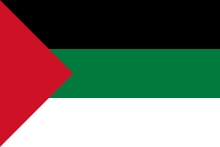| Revision as of 22:46, 4 May 2014 editOmar-toons (talk | contribs)5,164 editsNo edit summary← Previous edit | Revision as of 22:48, 4 May 2014 edit undoOmar-toons (talk | contribs)5,164 edits →Former flags with the Pan-Arab colorsNext edit → | ||
| Line 36: | Line 36: | ||
| File:Flag of Egypt 1972.svg|<center>] (] (1972–1984), ] (1972–1980), and ] (1972–1977))</center> | File:Flag of Egypt 1972.svg|<center>] (] (1972–1984), ] (1972–1980), and ] (1972–1977))</center> | ||
| File:Flag of Libya (1969–1972).svg|<center>] (1969–1972)</center> | File:Flag of Libya (1969–1972).svg|<center>] (1969–1972)</center> | ||
| File:Flag of Egypt (1952-1958).svg|<center>] (1952-1958)</center> | |||
| File:Flag of Iraq 1924.svg|<center>] (1921–1959)</center> | File:Flag of Iraq 1924.svg|<center>] (1921–1959)</center> | ||
| File:Flag of the Arab Federation.svg|<center>] (1958)</center> | File:Flag of the Arab Federation.svg|<center>] (1958)</center> | ||
Revision as of 22:48, 4 May 2014
| This article needs additional citations for verification. Please help improve this article by adding citations to reliable sources. Unsourced material may be challenged and removed. Find sources: "Pan-Arab colors" – news · newspapers · books · scholar · JSTOR (August 2009) (Learn how and when to remove this message) |


The Pan-Arab colors are black, white, green and red. Individually, they have their origins in the flags of prominent empires and dynasties in Arab history. They are combined according to two sub-sets: the Arab Revolt colors, coming from the 1916 Arab Revolt flag, and the Arab Libertation colors, in which green is less significant.
Each of the four Pan-Arab colors were intended to represent a certain Arab dynasty, or era. The black was the color of the banner of Muhammad; white was used by the Umayyad Caliphate; green was used by the Fatimid Caliphate; and red was the flag held by the Khawarij.
The Arab Revolt colors are used currently in the flags of Jordan, Kuwait, Palestine, the SADR, and the United Arab Emirates. The Arab Liberation colors appear in the flags of Egypt, Iraq, Sudan, Syria, and Yemen. Formerly, Pan-Arab colors were shown in the flag of Libya as well as in flags of the short-lived United Arab Republic, Arab Federation and Federation of Arab Republics.
Current flags with Pan-Arab colors
Sovereign states
Partially recognized states
Unrecognized territories
Former flags with the Pan-Arab colors
-

Federation of Arab Republics (Egypt (1972–1984), Syria (1972–1980), and Libya (1972–1977)) -

Libya (1969–1972) -

Egypt (1952-1958) -

Iraq (1921–1959) -

Arab Federation (1958) -

Iraq (1959–1963) -

Iraq (1963–1991) and Syria (1963–1972) -

Iraq (1991–2004) -
 Syria (1920-03-08 to 1920-07-24)
Syria (1920-03-08 to 1920-07-24) -

Syria (1932–1958 and 1961–1963) -

United Arab Republic (1958–1961) -

North Yemen (1962–1990) -

South Yemen (1967–1990) -
 Arab Islamic Republic (1974)
Arab Islamic Republic (1974)
-
 Hejaz (1917–1920)
Hejaz (1917–1920)
-
 Hejaz (1920–1926)
Hejaz (1920–1926)
-
 Hejaz (1926–1932)
Hejaz (1926–1932)
Former Arab flags
-

Rashidun Caliphate
(632–661) -

Umayyads
(661–750) -

Abbasids
(750–1258) -

Fatimids
(909–1171) -

Ayyubids
(1171–1341) -

Mamluk Sultanate
(1250–1517)
See also
References
- ^ Pan-Arab Colours, crwflags.com
- Abū Khaldūn Sati' al-Husri, The days of Maysalūn: A Page from the Modern History of the Arabs, Sidney Glauser Trans., (Washington D.C.: Middle East Institute, 1966), 46.
- Mahdi Abdul-Hadi, Palestine Facts: The Meaning of the Flag, passia.org
External links
- Pan-Arab colors
- Evolution of the Arab Flag, by Dr. Mahdi Abdul-Hadi (in Arabic)









